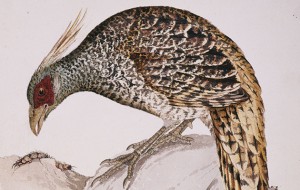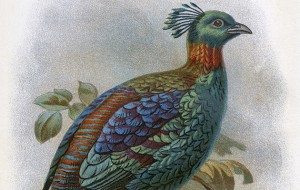Pheasants may be the commonest gamebird, but their history is distinctly uncommon
natural history
Reeves’s pheasant: a high flyer and hefty fine
The Reeves’s pheasant will occassionally appear at a British shoot, but only as an escapee that will cost you a hefty fine if you shoot it. Do you know the history of what you are shooting? Read the history of the pheasant to impress at the shoot lunch. REEVES’S PHEASANT…
Cheer pheasant: a Himalayan native
The Cheer pheasant originates from the Himalaya region from western Pakistan to Nepal, but it is a vulnerable, threatened specie that has teetered on the brink of extinction. For a more familiar pheasant to our shores, read Caucasian pheasant: the Old English Blackneck. CHEER PHEASANT The Cheer pheasant is native…
Grey junglefowl: the wild ancestor
The Grey junglefowl is very distinctive, with neck hackles dotted with pale yellow spots, and its feathers have been in such high demand a ban was put in place in 1968 on exporting the birds from India. For a pheasant closer to home, read Caucasian pheasant: the Old English Blackneck.…
Satyr tragopan: the Crimson-horned pheasant
The Satyr tragopan, also known as the Crimson-horned pheasant, can be found in thickly forested mountain areas of India, Tibet, Bhutan, China and Nepal, and its appearance is as striking as its home. With deep crimson feathering interspersed with white spots, this pheasant is prized for its appearance. For another…
Impeyan pheasant: Himalayan monal
The Impeyan pheasant, also known as the Himalayan monal, is far bigger than other pheasants, standing at more than 2ft tall. It also lives between 8,000-15,000ft, which is higher than any other pheasant. For another pheasant that can be found in the Himalayas, read about the striking Satyr tragopan: the…
Caucasian pheasant: the Old English Blackneck
The Caucasian pheasant was originally brought to England by the Romans, but a long history hasn’t saved their ever declining numbers. Finding a pure Caucasian pheasant is very rare, and while you can buy the birds from game farms they are usually cross-breeds. The World Pheasant Association (WPA) are part…
Monster Moths in Britain
Monster moths are kind creatures and often misunderstood. Many people think of moths as rather boring little brown jobs that can be a nuisance when you sit out on a warm summer’s evening as they flutter around lights and charge headlong into candle flames or – even worse – your…
Glorious Goshawk
Dame Juliana Berners wrote, in the Boke of St Albans, of the allocation of species of hawk and falcon to their corresponding human ranks in mediaeval society: And yit ther be moo kyndis of hawkes/Ther is a Goshawke and that hauke is for the yeman/Ther is the Tercell and that…
Hawkmoth
You do not need to travel to exotic places to find beautiful and exotic looking moths, there are stunning examples here in the UK and all you need is a lamp and a sheet to catch them.














